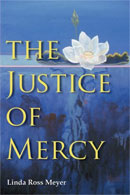The Justice of Mercy

Author: Linda Ross Meyer
Publisher: Ann Arbor, MI: The University of Michigan Press, 2010. 264p.
Reviewer: Carol S. Steiker | March 2012
The tension between the supreme – even divine – goods of justice and mercy has generated a rich literature across the disciplines of law, moral philosophy and theology. Theology offers a resolution of the tension rooted in the perfection of divine love, a recourse not possible for law or philosophy. In the human realm, how can we reconcile the absoluteness and centrality to human coexistence of the demands of justice (“No justice, no peace!” goes the protest chant) with the recognition of our shared frailty and humanity that mercy offers? If the various answers offered to this question teach us anything, it is that the reconciliation of justice and mercy is not easy or obvious.
There are essentially four choices for reconciling justice and mercy in the realm of human relations and institutions: 1) Reject the conflict and subsume both justice and mercy into a larger framework of commensurable goods (“social welfare”). 2) Soften the absoluteness of the demands of justice and clear some space for mercy (usually at the margins). 3) Reject mercy as incompatible with justice (or as already incorporated within it). 4) Reject justice as incompatible with mercy (or as incorporated within it). Linda Ross Meyer, in The Justice of Mercy, seeks to rebut the image of mercy as a threat to justice – to counter the portrayal of mercy as “the madwoman in the attic of law” (p. 11) and to restore mercy to the position of “the lady of the house” (p. 49). Meyer thus seeks to “flip the accepted relationship between justice and mercy on its head” (p. 3) and to “give pride of place of mercy” (p. 2). In short, Meyer chooses option 4. This is not one of the more popular choices, because it requires the wholesale repudiation of retributive justice and associated “rule of law” values. Meyer’s alternative account of the priority of mercy is beautiful, moving, and at times even lyrical. It may nonetheless fail to convince the mercy skeptic, because it sometimes slights the things that would be lost if justice, rather than mercy, became supererogatory or dispensable.
Meyer begins by questioning law’s “rationalist catechism” or what she calls its “kanticism” – by which she means the priority of reason over experience, and the confidence that reason can produce rules of universal application (p. 10). Meyer argues that our faith in reason is unfounded, as judgment in context is crucial to the working out of the rules that reason produces. Context and connection come first, in time and priority, and we should start there – with Heidegger’s concept of “being-in-the- world-with-others” (p. 26) rather than with Kant’s categorical imperative. Meyer builds on the work of Heidegger and Levinas to argue for a law and ethics based on human connectedness rather than human reason. That interconnectedness is mercy, in Meyer’s view – because it is given to us without desert. Mercy toward those who fail to live up to the inherent responsibilities of connection is a way of repairing or recovering that original interconnectedness. In Meyer’s own words: “[P]rimal mercy or grace (understood as our ungrounded and undeserved obligation to the call of an other) must be the ground of justice” (p. 42).
To clear the way for her affirmative account of mercy, Meyer must first reject the retributivism of Kant and Hegel. She works through a list of objections, large and smaller, from a variety of perspectives. Some of Meyer’s objections to retributivism focus on its internal inconsistencies. For example, Meyer argues that Kant’s insistence on respecting an offender’s dignity prevents a Kantian retributivist from truly giving back an offender “his own deed” as punishment, for that deed did not include respecting the victim’s dignity. Meyer also attacks retributivism from an external perspective. For example, she argues that retributivism fails to offer a convincing explanation for our widespread belief, reflected in the criminal law, that the harm caused by an offender has significance for the offender’s punishment, independent of the offender’s criminal intent. Meyer also independently assesses and critiques “victim-centered” and “communication” variants of retributivism. Many of Meyer’s objections to retributivism are familiar, and some are quite serious, but I suspect that enthusiasts of retributivism – and even more faint-hearted supporters like myself – will fail to find in this set of critiques a mortal blow.
More moving and more original is Meyer’s affirmative case for mercy. From the ground of primal “mercy” or interconnectedness, Meyer builds a case for our responsibility for and to others. Thus, wrongdoing consists of “a failure to attend to others” (p. 71) or, in the words of Samuel Pillsbury, a mental state of “obdurate indifference” (p. 72). In a world where connectedness is prior to and has priority over reason, punishment for wrongdoing is not a deserved penalty willed by reason, but rather is a means to restore connection when it has been sundered. Punishment is “the shared memory of a wrong as wrong” that leads to “a settlement” or sentence by a “compassionate witness” that both provides a finite end to the narrative of wrongdoing and sets the terms for future reintegration of the wrongdoer (p. 87).
Meyer explains the implications of this account of responsibility, wrongdoing, and punishment for the both the substantive criminal law and criminal procedure. On the substantive criminal law side, Meyer elaborates the implications of a mercy-based conception of crime for doctrines like proximate causation, offense grading, and defenses. For example, she argues that if interconnectedness is the foundation of wrongdoing, it better explains the emphasis placed by current doctrine (and common moral intuition) on the degree of harm or suffering caused by an offender, quite apart from the offender’s culpable mental state. On the procedural side, Meyer’s mercy-based conception of crime imbues the trial process with new meaning. With “its personal testimony and right to confrontation,” the trial process represents “the coming face-to-face with the other, looking together at the wrong as wrong and experiencing the pain and shock of it together for the first time” (p. 83).
Meyer concludes the first half of her book (her abstract case for mercy) with a list of “questions and objections” (pp. 88-100). This compendium was a frank, helpful, and engaging feature that should serve as a model to us all; some such discussion would improve many other scholarly works. In the second half of the book, Meyer takes her model on the road, so to speak. True to the narrative rather than analytical form of the mercy she advocates, Meyer does not seek to address in a comprehensive way the implications of mercy on the ground. Rather, she addresses two particular contexts – mercy in executive pardons and in the military justice system. Then she offers two re-readings of well-known novels (Dumas’ The Count of Monte Cristo and Coetzee’s Disgrace) through the lens of mercy rather than retributive justice. The pardon discussion is one of the least successful parts of the book, because Meyer starts with a given taxonomy of pardons that does not mesh well with the account of mercy that she develops in the first half of the book. The military justice chapter works better, because the emphasis on interdependence, teamwork and loyalty in military culture is an intensified version of the interconnectedness that forms the foundation of Meyer’s account of mercy. Meyer uses these features of military culture to explain and justify patterns of leniency in military cases, and by extension in the broader criminal justice system. The concluding chapter, though idiosyncratic in its readings of Dumas and Coetzee, is beautiful and evocative, with positively lyrical prose that helps bring to vivid life Meyer’s view of a merciful world.
Each of the two halves of the book – the philosophical case for mercy in Part One and the “application” of the mercy paradigm to law and literature in Part Two – offers many rich insights, but also raises further questions. The biggest question left hanging in the first half of the book is the role of “justice” in a system in which mercy reigns supreme. Having thoroughly rejected retributive justice, it is not clear whether criminal punishment is necessary or even justified in Meyer’s account, especially if it routinely fails (as our current system clearly does) to inspire the remorse that seems to be its primary function in Meyer’s rendering. Perhaps institutions quite different from those of the criminal justice system would be better suited to bring about the remorse of the defendant and the reconnection of the defendant and the victim – something more along the lines of victim-offender mediation, truth and reconciliation commissions, or restorative justice initiatives. In the absence of a retributive demand for just punishment, there is obviously no longer a conflict between justice and mercy, but at a cost. The idea that wrongdoing demands punishment (“No justice, no peace!”) becomes not just rebuttable but incoherent. And the “rule of law” values that come along with retributive justice – equality, proportionality, predictability – appear unnecessary, indeed impossible, as well. To be fair, Meyer does address at least a part of these concerns in her “questions and objections” at the end of Part One (especially “Does this theory create inequality?”), but not in a comprehensive fashion.
Part Two left me with two different sorts of questions. First, the legal applications of Meyer’s theory of mercy to pardons and military justice left me wishing that she had worked through more systematically the implications of her theory for all of the discretionary actors within the criminal justice system. What would it mean for police officers, prosecutors, jurors, sentencing judges, executives, and parole boards to be merciful? What do the different roles and institutional contexts of each of these discretionary actors mean for their ability to act mercifully in a normatively desirable way? Meyer suggests that her exploration of mercy in the pardon context should be extendable to other institutional actors, but this claim strikes me not only as wrong, but as surprisingly so for someone as sensitive to context as Meyer. Second, the literary application of Meyer’s theory in her readings of Dumas and Coetzee gives short shrift to the more conventional readings of these works. For example, my memory of reading the The Count of Monte Cristo is that it feels like a celebration of retributive justice and a warning only against exceeding the proper bounds of such punishment (don’t get carried away, don’t punish the innocent, etc.). And Disgrace feels like a mocking refutation of exactly what Meyer’s mercy seems to demand – externally manipulated remorse and apology. Meyer’s idiosyncratic readings are beautifully rendered, but they engendered in me exactly the sorts of “questions and objections” that she so artfully anticipated in Part One and might have fruitfully paid more heed to in Part Two.
At a time when the American criminal justice system seems excessively harsh in relation both to the rest of the world and our own past practices, the exploration of a radically different approach to crime and punishment is welcome, if it can help us better understand the costs of our current practices and possible alternatives. Meyer’s book is not only timely, it is engaging and beautifully crafted, though sure to be controversial. A world in which mercy is elevated to “the lady of the house” suggests that justice has been demoted (to “manservant” perhaps?) – an inversion that may be exhilarating, or scary, or both.
Carol S. Steiker is the Henry J. Friendly Professor of Law at Harvard Law School


